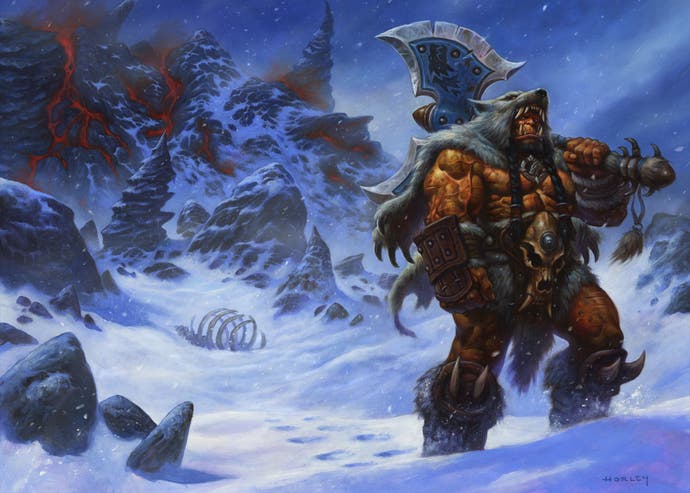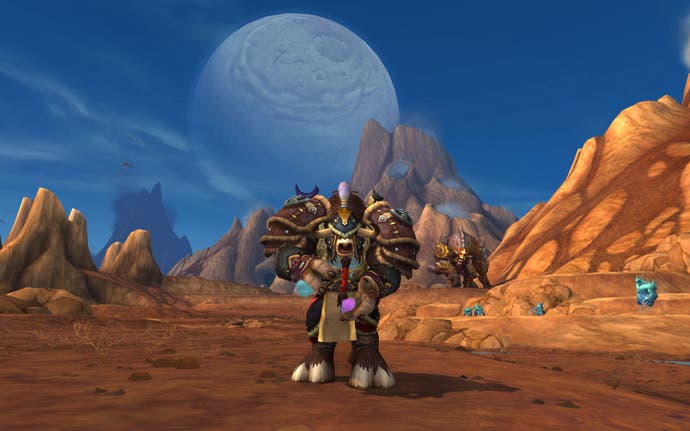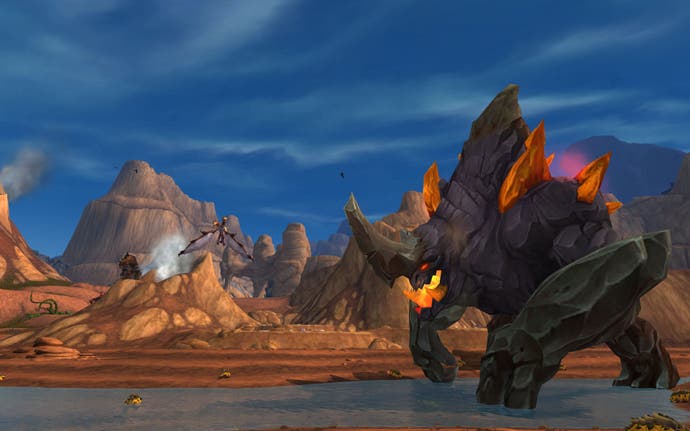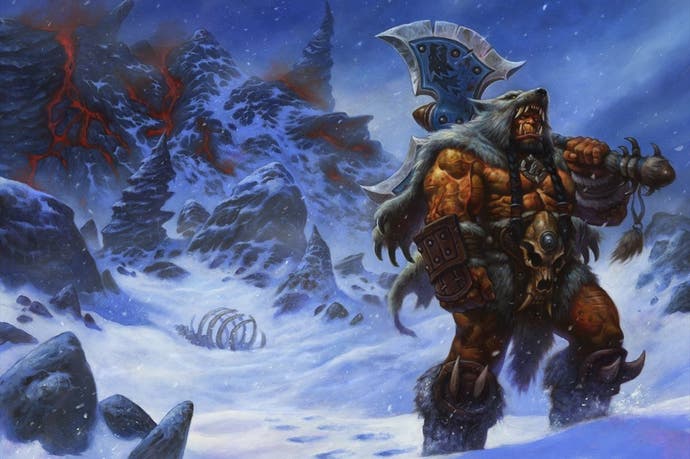Games of 2014: World of Warcraft: Warlords of Draenor
Everything old is new again.
"You can never go back. Or can you?" I wrote when I named World of Warcraft my game of the generation. It turns out that you can. I have.
This story doesn't start the way it has done for so many others: with a combination of peer pressure from old guildmates, the good word of mouth around WOW's fifth expansion Warlords of Draenor, and the free boost to level 90 that shortcuts you straight to the new content. It's not the tale of a former addict's bewildered return so eloquently told by Bertie either, because the truth is I'd never really been away. Though I hadn't played seriously since Wrath of the Lich King, I'd always enjoyed revisiting Azeroth for a spell every now and again - albeit a shorter, more half-hearted spell every time, with a longer hiatus in between.
No, I started playing WOW again because my wife bought a new laptop. (This was about six months before Warlords was released.) She installed Blizzard's peerless MMO on it, not at my behest, nor the behest of her childhood friend who had healed Molten Core runs back in the day and had fruitlessly tried to persuade her to join then, but because another friend of hers had started playing. That friend had started because her colleague had talked her into it. The colleague was playing because her boyfriend had got her involved. And so on. That's the power of a great social game; it never dies, living on without you, finding generations of new players. And then it circles back around to find you when you least expect it and by the unlikeliest route.
It sounds scary, insidious almost, but it's also the best reason to install a game like World of Warcraft: to play with friends. That's why this return was different for me - why it was better. I started a new character, a monk, to play with my wife, and we ran around the game's glorious world together, savouring the levelling, a happy-go-lucky adventuring duo. I may never be able to have those heady days of 2005 back, but seeing it all for the first time through her eyes was a pretty good substitute. Thanks to the Cataclysm expansion's retrofit, much of the questing was new to me, too, and the monk proved to be yet another brilliant piece of class design. And, dear God, the game is still addictive and slick and expansive and joyous and rhythmic and ruthless and fun. Hooks beget hooks. You don't want to come up for air - until suddenly you find you can't breathe any more.

That did happen to me eventually, somewhere in the lurid strangeness of Outland - not coincidentally, now the oldest content in the game - and I left Mrs Oli to carry on solo. I've just played this game too much, I thought. You can never go back, I thought. But then Warlords' release rolled around, with a continent of new quests and dungeons to discover. I'd even heard they'd introduced a button that automatically sorted the contents of your bags for you - just imagine! That level 90 upgrade icon was already gleaming on my character select screen. It would only take one click.
There are a number of reasons this expansion pack for a 10-year-old game has been quite as successful as it has. (It has taken subscriptions back over 10 million, the biggest reversal of WOW's gentle decline in subscribers since its 2008/9 peak.) But that level 90 upgrade option - with one boost included in the price of the expansion - must be the most important reason of all. It was a marketing masterstroke aimed at the game's vast constituency of lapsed players, offering a way to make the gap between you and the game, between you and your friends - a gap that might have yawned wide over years - disappear in a single click. The level 90 boost was also far from being a simple game design challenge: how to introduce, or reintroduce, mechanics that had been layered in over dozens of hours of gameplay and tweaked over a decade of development? How to catch players up on parallel progress tracks like the crafting professions? These problems were solved with an elegance, an eye for both detail and accessibility, that spoke of the WOW's team's almost unique experience tuning and re-engineeering a game that has been at the top for 10 years.

It would have been for nought if the destination hadn't made it worthwhile, of course. Happily, Draenor is the finest new adventuring zone to grace World of Warcraft since Wrath of the Lich King's Northrend.
Like most MMOs, WOW has always had a strange relationship with story. It has an absurd overabundance of the stuff, which is mostly a good thing; it makes for the rich textual and textural tapestry an online world needs. But it has historically struggled to link the epic sweep of its main storyline - a tortured, borderline incomprehensible soap opera whose principal struggles play out in top-tier raids - to the variously memorable or forgettable vignettes of the questing, and the almost disgraceful surplus of footnoted lore.
Warlords' premise isn't promising. It's the kind of time-travel, parallel-universe retcon that's beloved of fan communities and an off-putting tangle to everyone else. But Blizzard has used this as a way to revive the spirit, as well as some of the characters, of Warcraft's strategy-game heyday, and hit the tones and themes that have always served this fiction best: that is to say, warring clans, peoples divided, a savage and fertile young world, pathos and hubris and humour. For the most part, Warlords is not about battling the roaring, existential mega-threats that have dominated the game at other times - the old gods, the demonic crusades, the evil dragonflights. It's about picking a side in the struggle to survive. Despite its colourful style and outlandish setting, this is fantasy epic on a human scale - by Warcraft's standards, at any rate.

At its best, the questing and dungeon content of Warlords of Draenor sells that better than any expansion has before it. There are zones like Frostfire Ridge, where a noble orc clan resists absorption into the brutal Iron Horde, or Spires of Arak, where a cursed caste of withered, flightless bird-people struggle against ruling pure-blood zealots; in these, quests are given strong narrative grounding by persistent characters you'll end up caring about more than any other in WOW's history. And there are dungeons like Shadowmoon Burial Grounds, with evocative encounters that don't just test a party's skill but bring the lore to life as you clash with some of Warcraft's most famous names.
Inevitably, the deeper you get into Draenor, the more the narrative burden shifts onto the dungeons and raids from the questing, which gets more prosaic in the later stretches. But this is still the first time since Lich King the game has created that thrilling sense that the entire player-base is embarked on a grand adventure together, with a unified purpose. In games, the word "campaign" is usually used to talk about single-player storylines, but in this multiplayer context it could hardly be more appropriate.
It's this sweeping, cohesive quality that makes Warlords a high watermark for WOW (and what a pleasant surprise it is for it to reach one so late in its life). It's not really in the new features and changes - which are the usual mix of sensible streamlining and updates, systems meddling of variable success, yet another half-hearted attempt to get world PVP going, and Blizzard's continuing and largely successful drive to get more players to see more of the dungeon and raid content.

If anything, it's a more modest feature list than usual, with one enormous exception: garrisons. These customisable home bases - which act as crafting and adventuring hubs and involve a plethora of mini-games, routines, hooks and sub-hooks - incorporate themes and thinking from Warcraft's strategy roots, from player housing in other MMOs and even from mobile base-building games like Clash of Clans to keep players logging in and involved in a permanent loop of upwardly-mobile clicking. In the early days of Warlords' release, your garrison was by far the most exciting thing about it, and a powerful incentive to log in for a fiddle. But after a couple of months, you start to question whether they were a wise move. By condensing so much of WOW's busywork into a single space and a single knot of interconnected systems, they can rapidly make the game seem like a meaningless, self-sustaining chore machine (which is, ironically, just how many of those lapsed players had come to feel about it when they cancelled their subscriptions).
Out in the world, though, where this game has always been best, Warlords of Draenor soars. It has the elder WOW's smooth manners, storytelling prowess and generosity of spirit. But it also has the young WOW's sense of adventure and discovery, presenting an untamed world where war is waged and rare monsters with tough hides roam, tempting you to test your mettle. It's a great rejuvenation. In terms as objective as possible for a nostalgic old hand like myself, it's as good as World of Warcraft has ever been. In subjective terms, it's pretty close for me too, because I've had the good fortune to play this expansion the way this game is always meant to be played - in company.
I was right: you can never go back. But you can go forward.

















